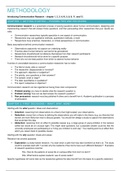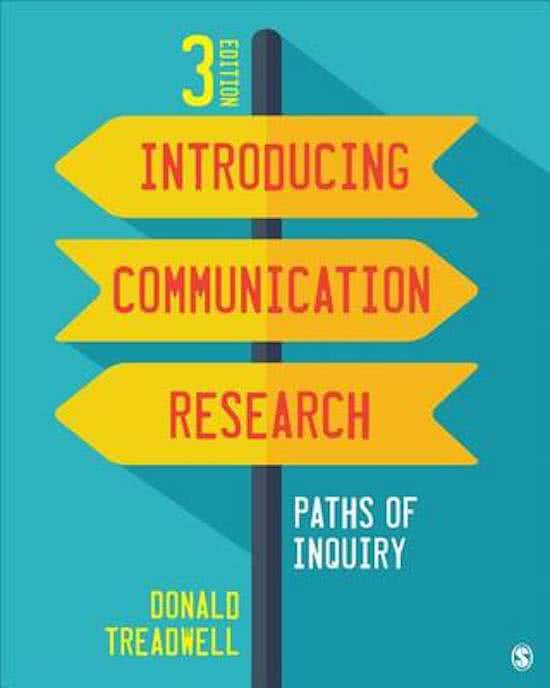METHODOLOGY
Introducing Communication Research – chapter 1, 2, 3, 4,10, 5, 8, 9, 11, and 12.
CHAPTER 1: GETTING STARTED – POSSIBILTIES AND DECISIONS
Communication research is a systematic process of posing questions about human communication, designing and
implementing research that will answer those questions, and then persuading other researchers that your results are
valid.
▪ Communication researchers typically specialize in one aspect of communication.
▪ Researchers may use qualitative methods, quantitative methods, or both.
▪ Researchers have empirical, interpretive, or critical perspectives on communication.
Basic assumptions behind communication research:
▪ Observations capture/do not capture an underlying reality
▪ Theories about human behavior can/cannot be generalized
▪ Researchers should/should not distance themselves from their research participants
▪ Research should/should not be done for a specific purpose
▪ There is/is not one best position from which to observe human behavior
A series of unavoidable decisions a communication researcher has to make:
▪ The field of study: wide or narrow?
▪ The researcher: dispassionate or involved?
▪ The approach: objective or subjective?
▪ The priority: your questions or their answers?
▪ The sample: small or large?
▪ The data: quantitative or qualitative?
▪ The report: subjective or objective?
Communication research can be regarded as having three main components:
1. Problem posing: you have to decide what the research question is.
2. Problem solving: how can we best answer the research question?
3. Peer persuasion: research must be published if others are to benefit from it. Academic publication is a process
of persuasion.
CHAPTER 2: FIRST DECISIONS – WHAT, WHY, HOW?
Starting with the what question: Ideas and observations:
▪ Induction: reasoning from observations to a theory that might explain your observations.
▪ Deduction: moves from a theory to defining the observations you will make to the theory (e.g. you theorize that
women are more likely than man to discuss grades. You would then design a study to capture the observations
that would test this idea.
▪ Abduction: reasoning from an effect to possible causes (e.g. a large group of young children in the campus
coffee bar would be an unusual sight. This might raise questions, but a plausible answer could be that the
university employees are participating in a “bring your children to work day”. Your starting point is an effect from
which you reason back to possible causes.
Starting with the why question: Goals and values:
Research has several purposes:
▪ Exploration: curiosity-based research. You start down a path that may lead nowhere but that’s ok. The study
could for example start with “I wonder why the residents of two dorms have such different lifestyles?”. Examples
of research questions could be:
RQ1: How do the patterns of social life on campus differ from dorm to dorm?
RQ2: What factors explain students’ use of social media?
Specific hypotheses will come later as the researcher gathers the data that will form the basis for a specific statement.
, ▪ Description: describes something, but leaves a reader wondering “why?”.
▪ Explanation: studies focused on explanation attempt to answer the “why” question. The research questions
and hypotheses for these studies are more specific than for exploratory studies. Example:
RQ1: Are patterns of student social life on campus related to the residence status of the student?
H1: Female students differ from male students in the language used to explain their use of social media.
▪ Prediction: Our explanations have greater credibility if they are capable of prediction. Some hypotheses you
could write if your research goal is to predict could be:
H1: Patterns of interaction within student work groups are predicted primarily by the residence status of
the students in the group.
H2: Swing votes will vote for the political candidate who most emphasizes local issues.
▪ Control: another goal of research may be control. Researching with a view to being able to predict and
manipulate physical processes such as digital recording. For communication, advertises for example want to
be able to control audience responses to advertising. Some hypotheses could be:
H1: Direct mail recipients are more likely to open mail pieces that resemble official government mail.
H2: Students are more likely to attend early morning classes if a tuition discount is offered for those
classes.
▪ Interpretation: the researcher attempts to understand human communication from the point of view of the
people doing it.
▪ Criticism
The above starting points may mix. It is possible to for example have an explanation without a prediction.
Starting with the how question: Methods and Epistemologies
▪ Epistemology: the question of how we know what we know. We might know as a result of a:
Tenacity: we’ve always done it or understood it that way;
Intuition: the hunch or the gut instinct;
Authority: because a credible source said so;
Rationalism: logic reasoning;
Empiricism: observation.
Scientific methods usually combine empiricism, rationalism, and positivism (the idea that phenomena are governed
by, and can be explained by, rules). Two strengths of this are openness and self-correction.
Basic assumptions about human behavior come together from a world view.
1. Worldview #1:
Nomothetic approach: human behavior is predictable, objectively measurable, and generalizable. Aims to
make generalization about human communication that will hold true across space and time. Prefers
quantitative methods.
2. Worldview #2:
Idiographic approach: sees human behavior as individualistic, unpredictable, and subjective. Assumes
that knowledge is socially constructed out of interaction between people and is subjective. Research based
on these assumptions attempts to describe and assess the subjectivity and individuality of human
communication, rather than aiming to discover universal laws. Prefers qualitative methods.
Ontology: the nature of what we study (the foundational beliefs and arguments about human behavior).
Before you get started with your own research you start with reading the work of others. Next step is to identify key
constructs and operationalize them. Constructs are ideas or concepts. Operationalizing them means to define them
in such a way that they can be measured.
Example:
You are interested in the relationship between playing videogames and academic performance. To operationalize these
two constructs basically means that they are defined in such way that other researchers could replicate your study.
See the table below for examples.
, CONSTRUCT
Involvement in gaming Academic performance
Operationalizing the constructs
Time spent on gaming Class rank
Money spent on gaming Number of academic awards
Number of memberships in gaming clubs Current grade point average
Number of online personas/avatars Cumulative grade point average
Percent of time spent with other gamers Class participation as rated by faculty
Number of gaming software titles owned Class attendance as recorded by faculty
Percentage of gaming terms used in conversation Number of memberships in academic honor societies
Next, we create hypotheses (predictions). A hypothesis is a statement about the relationship we expect to find between
the variables. Hypotheses can simply state that there will be a relationship, specify the direction of the relationship, or
state that no relationship is expected.
Three types:
1. Two-tailed hypothesis: state that there is a relationship between two variables but do not specify the direction
of the relationship.
Example: H1: There is a relationship between level of involvement in video gaming and academic
performance.
2. One-tailed hypothesis: require extra confidence because you commit to predicting the direction of the
relationship between the variables.
Example: H2: As time spent in video games increases, academic performance decreases.
3. Null hypothesis: specify there’s no relationship between variables.
Example: H0: There is no relationship between level of involvement in video gaming and academic
performance.
If preliminary reading and research does not give you the certainty to make a hypothesis (prediction) you develop a
research question.
1. Open-ended research questions: ask whether there is a relationship between variables.
Example: RQ1: Is there a relationship between involvement in video gaming and academic
performance?
2. Closed-ended research questions: focus on a direction of relationship.
Example: RQ2: Does academic performance decline as involvement in video gaming increases?
Open-ended research questions are appropriate for an exploratory study when you don’t have a lot of evidence. With
additional evidence you can question the relationship between the variables.
To summarize:
▪ Communication researchers differ in ontology (how to define communication) and in epistemology (how best to
understand communication).
▪ Generally, researchers assume either that human communication is objectively measurable and can be
summarized in rules and generalizations or that communication is subjective and individualistic and must be
described as such.
▪ The process of induction, deduction, and abduction link observations to theory.
▪ Ways of understanding communication include tenacity, intuition, authority, and empiricism.
▪ The general purposes of research are description, explanation, prediction, control, interpretation, and criticism.
▪ Research may begin with specific hypotheses, general research questions, or no specific questions at all.





